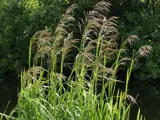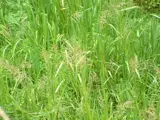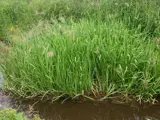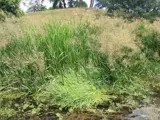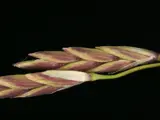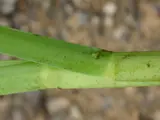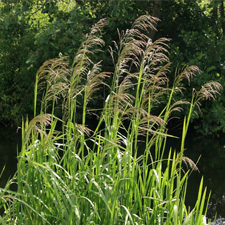 Reed sweet grass
Reed sweet grass
Common name: Reed sweet grass
Botanical name: Glyceria maxima
Management category: Sustained Control
Reed sweet grass originates from Europe and was introduced to New Zealand as an ornamental, small pond and stream plant. It was first recorded in the wild in New Zealand in 1906, with infestations now throughout the country.
Why is it a pest?
- Forms a dense monoculture in nutrient-rich water and wet ground.
- Matures quickly to form dense mats in nutrient-rich water and wet ground, out-competing native plants and degrading aquatic habitat.
- Increases flood risks and impedes recreational activities such as fishing and boating.
- Spreads by seed and rhizomes. Seeds are spread by water and wind, rhizomes spread outwards and fragment, with fragments rooting in wet ground.
- Also spread by machinery, animals and fishing gear.
- Tolerant of grazing, pollutants and mechanical damage.
Where is it found?
Wetlands, bogs, freshwater margins, lakes, and streams in open frost-free areas.
What does it look like?
- Grows aggressively to form large dense mats.
- Erect grass with shiny, bright green, soft leaves.
- Leaves grow to 60cm high, with rough edges and a pointed tip.
- Flower heads are open with numerous spikelets containing many long-lived seeds.
What are the rules?
Sustained Control
Sustained Control pests are well established in the region and preventing the spread is no longer a realistic objective. Management focuses on reducing general impacts of the pest. Landowners/ occupiers are responsible for the control of these pest species on their land. Council may enforce control.
How do you get rid of it?
Begin all control work at the top of the catchment, and minimise site disturbance and the creation of bared areas.
- Spray (spring to autumn). Resource consent may be required to spray over water.
- Machine dig all year round. Dispose of fragments at refuse transfer station, dry out and burn, or bury. Follow up with limited spraying.
- Weedmat. Difficult to apply, need to cover all of infestation to avoid rhizome survival and leave covered 3-4 months
CAUTION: When using any herbicide or pesticide, PLEASE READ THE LABEL THOROUGHLY to ensure that all instructions and directions for the purchase, use and storage of the product, are followed and adhered to.
Read more on pest control advice, information and regulations.
Images

